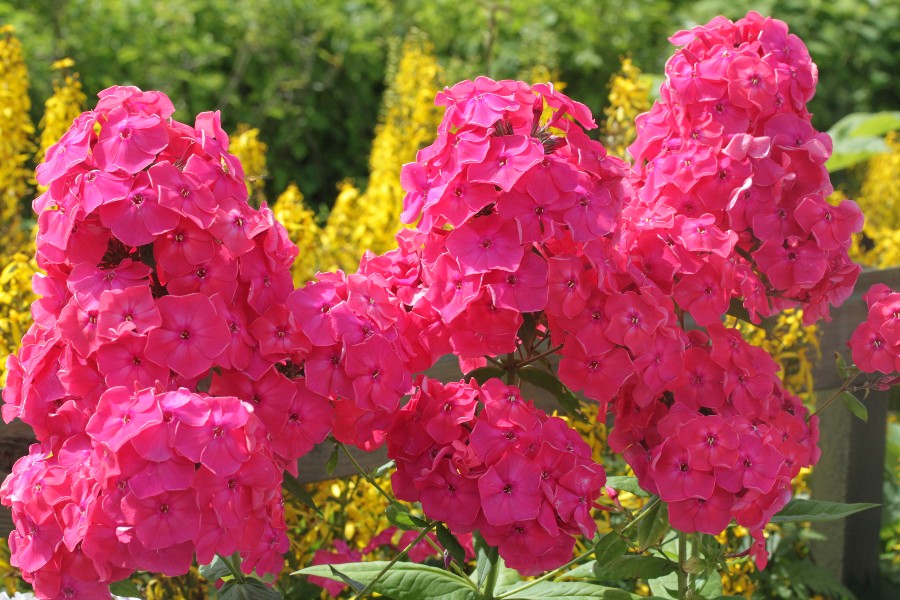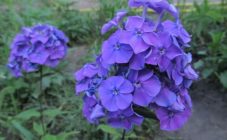Content:
Phlox (Phlox) is a herbaceous perennial or annual plant of the cyanide family (Polemoniaceae). The birthplace of the flower is North America. But over the course of many years, the phlox "stepped" outside America, first to England, and then to Russia. Here the heat-loving sissies had a hard time. In cold climates, many varieties died, and the strongest survived. And by the end of the nineteenth century, more than a hundred varieties were bred. Our breeders and originators have developed many varieties that differ from natural varieties. Phlox's color changed, eyes appeared in the center of the flowers, as well as a smoky coating on the petals.
Characteristic
Translated from the Greek phlox means “flamingo”, and it really is. When phlox blooms in the garden, like a multi-colored flame rages. The phlox genus comprises more than 60 different species and many different varieties. Plant height can be from 10 to 150 cm, depending on the variety. Flowers with a wonderful aroma are collected in corymbose or paniculate inflorescences. Phlox fruits are in the form of a box containing 2-3 seeds.
The flowers are bisexual, have both stamens and pistils. Only insects with a long proboscis can pollinate phlox, since the flower has a very interesting structure. 5 petals have grown together at the bottom into a long tube, inside which are both the stamens and the pistil.
Smoky phloxes are very beautiful and mysterious. It is as if an invisible artist applied the brush strokes on top of one color in a different tone. This subtle velvety can be silvery, gray-chestnut or ashy. This effect on the petals is different for each species. In some, it is noticeable in the evening or in cloudy weather, in others - an hour after blooming. Some petals are completely covered with haze, while others have only a border.
Description of phlox varieties
Phlox smoky coral
Russian originator Pavel Gavrilovich Gaganov created the Smoky Coral variety back in 1935. This variety has got an unusual color of petals - coral (pink with an ashy bloom and a cherry eye). The colors fade slightly in the sun. The inflorescences of this variety are very large and dense.
Prince of silver
The variety is relatively young. Khvatova V.N. brought him out in 2001. It is a strong bush with a lot of leaves, 85 cm high. It has adapted well to the weather conditions of the cool summer in the northern regions of our country. The flowers combine dark pink and lilac colors. In the center there is a radiant star, the color of which changes from white to purple. Along the edge of the flower, there is a barely noticeable silvery-gray haze. The diameter of a single flower is about 3.5 cm.
Spartan
This variety is of unknown pedigree. He has an unusual, if not unique, coloring for a smoky phlox - a bright, catchy, reddish-raspberry-pink, with time, a silvery haze appears around the edge. The stem is very strong, up to 80 cm high, woody by the end of flowering. This variety grows slowly and is difficult to graft.
Old Lighthouse
This variety is distinguished by original flowers in inflorescences. The color of the flower is ash-purple, and the middle is in the form of a bright crimson star. The haze on the petals is visible in any weather.
Phlox smoky soufflé
In 2013 V.V.Korchagin and V. G. Borisova brought out the phlox variety from the Souffle series. The variety turned out to be very interesting. Slightly wavy petals have a pointed shape. The color of the petals is lilac with a slight haze and a purple center, the diameter is about 3.5 cm. The newly blossoming flowers are much brighter than those that blossomed earlier. Inflorescences are dense, have a rounded-conical shape.
Old man
Yuri Repyev in his youth was familiar with Pavel Gaganov, from whom he "became infected" with a love of phlox. Over time, Yuri Repyev bred many different varieties, one of them is the Starina variety. The flower is 4 cm in diameter, at the beginning of flowering has a rich, intense, purple-violet color. During flowering, rare threads of "gray hair" appear on the petals at first, and later the whole petal is covered with a silver haze, only the middle reminds of "former youth". This flower in appearance is somewhat reminiscent of the famous smoky phlox Dragon, the difference is a more flexible character - it takes root and grows better. The height of the bush reaches 80 cm.
Faina Ranevskaya
The author of this variety is O.K. Kudryavtseva, it was bred in 2006. The bush about a meter high is sprinkled with dense large inflorescences that have a pyramidal shape. The bush is 80-90 cm high and consists of thick sturdy stems. It grows very well and has an increased immunity to disease. Flowers with a diameter of 3.8 cm are light red, very bright in color. This variety is visible from anywhere in the garden. He is so bright and stately, like Faina Ranevskaya herself.
Planting phlox
Phloxes love sunlight and do not like stagnant moisture. The soil should be fertile, preferably light loam.
Landing
Phlox is best planted in spring or in the second half of summer. Regular watering must be ensured after planting.
Watering
Phloxes simply need deep watering (10-15 liters per plant), especially when the plant is growing and blooming. Closer to autumn, phloxes are watered just as abundantly, but much less often.
Fertilizers
If a sufficient amount of fertilizer has been applied during planting, there may be a minimum amount of fertilizing. Well, if there is still a need to feed the plant, nitrogenous fertilizing is introduced at the beginning of growth, and after the phloxes have faded, they need phosphorus and potassium.
Division
About every 5 years, the bushes need to be rejuvenated. To do this, divide the bush in half, remove one half and plant it in another place (you can divide it again), and pour fertile soil into the formed depression.
Diseases and pests
With proper agricultural technology, phlox bushes rarely get sick. Biologicals can be used as a prophylaxis. But if a disease is noticed on the plant, then it must be immediately treated with fungicides. It is necessary to enter strictly according to the instructions so that it does not turn out to be overkill.
With just a little effort, beautiful phloxes will burst into flames.














